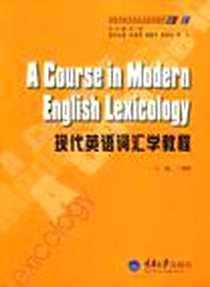《现代英语词汇学教程》
《现代英语词汇学教程》
出版时间:2004-10
出版社:重庆大学出版社
作者:丁建新 编
页数:164
字数:202000
《现代英语词汇学教程》前言[E]
进入21世纪,我国高等教育呈现快速扩展的趋势。为适应社会、经济的快速发展,人才的培养问题已经比我国任何一个历史时期都显得更为重要。当今,人才的能力和素质的衡量越来越多地采用国际标准,人才的外语水平自然地也越来越受到培养单位和用人单位的重视,由此引发了对大学外语教学模式、教材和检测机制的新一轮讨论,掀起了新一轮的大学英语教学改革。作为外语师资队伍和外语专业人才培养的高等学校英语专业,相比之下,在教学改革思路、新教材开发和新教学模式探讨等诸方面均显得滞后。尽管高等学校外语专业教学指导委员会英语组针对当前高校发展的新形式和外语专业人才培养的新规格、新模式和新要求,修订出了新的《高等学校英语专业英语教学大纲》,并结合21世纪外语人才培养和需求的新形势,制定了由教育部高等教育司转发的《关于外语专业面向21世纪本科教育改革的若干意见》,就英语专业的建设提出了指导性的意见,但在实际工作中这两个文件的精神尚未落实。
为此,重庆大学出版社和外语教学界的专家们就国内高等学校英语专业建设所面临的新形势做了专题讨论。专家们认为,把“大纲”的设计和“若干意见”的思想和理念变为现实的一个最直接的体现方式,就是编写一套全新理念的英语专业系列教材;随着我国教育体制的改革,特别是基础教育课程标准的实施,适合高等学校英语专业教学需要的教材也应做相应的调整,以应对中小学英语教学改革的新要求;高等学校学生入学时英语水平的逐年提高和就业市场对外语人才需求呈多元化趋势的实际,对高等学校英语专业的人才培养、教学模式、课程设置、教材建设等方面也提出了严峻挑战.应对这些挑战,同样可以通过一套新的教材体系来实现。
迄今为止,国内尚无一套完整的、系统的英语专业系列教材;目前已有的教材出自不同的出版社,编写的思路和体例不尽相同;现有的教材因出版时间较早,内容、知识结构、教学方法和手段已经不能适应新的发展要求;传统的教材设计多数基于学科的内在逻辑和系统性,较少考虑学习者的全面发展和社会对人才需求的多元化。
自2001年开始,在重庆大学出版社的大力支持下,我们成立了由华中、华南、西南和西北地区的知名专家、学者和教学一线教师组成的《求知高等学校英语专业系列教材》编写组,确定了系列教材编写的指导思想和总体目标,即以《高等学校英语专业英语教学大纲》为依据,将社会的需求与培养外语人才的全面发展紧密结合,注重英语作为一个专业的学科系统性和科学性,注重英语教学和习得的方法与规律,突出特色和系列教材的内在逻辑关系,反映当前教学改革的新理念并具有前瞻性。
《现代英语词汇学教程》内容概要[E]
《现代英语词汇学教程》是《求知高等学校英语专业系列教材》之一,它面向英语专业本科学生,对词汇学的一些传统内容进行了合理的整合,同时又吸收了近年来词汇研究的诸多新成果,涵盖了词汇与语法的关系、英语词汇的词源学研究、构词法、词的意义及意义关系、词的语用研究、多词表达(含搭配、词组和习语等)及利用语料库考察词汇型式等主要论题,还附有对中国英语学习者学习词汇十分有用的一些工具性内容,如常用词根表、词缀表等。各章练习力图式样灵活,使学生无需死记硬背就可以巩固所学知识。全书既有共时的研究,又有历时的视角,试图使学生在掌握词汇学的基本概念和内容的同时,将他们引导到词汇这一英语语言中最具人文色彩的部分。
《现代英语词汇学教程》作者简介[E]
丁建新,男。英语语言文学博士。现任职于中山大学外语学院英语系,人选中山大学人才引进“百人计划”和广东省高校“千百十工程”培养对象。2004年曾受“中山大学岭南基金”资助在香港城市大学英语与传播系做学术访问和研究工作。获2006年“国家留学基金”。主持国家社会科学基金项目“叙事的社会符号学研究”以及广东省英语教改与实践培育项目“功能语言学视角中的高校应用英语教改研究与实践”。在重要学术期刊及大学学报上发表文章二十余篇。完成专著《预制性语言在广告语域中的话语分析》、《批评视野中的语言研究》(与廖益清合作)和《叙事的批评话语分析:社会符号学模式》三部。主编《功能语言学的理论与应用第八届全国功能语言学研讨会论文集》。主持翻译“伦敦语言学派”创始人弗斯论文集。研究方向:功能语言学、批评语言学、体裁分析、翻译理论与实践。
《现代英语词汇学教程》书籍目录[E]
1 Introduction. Word, Vocabulary and Lexicology 1.1 The notion of 'word'
1.1.1 Do words exist?
1.1.2 Bloomfield's definition of word
1.1.3 Characteristics of words 1.2 The organization of English vocabulary
1.2.1 The syntagmatic and paradigmatic relations
1.2.2 Word classes
1.2.3 Lexical fields 1.3 Lexicology and other levels of linguistic analysis
1.3.1 Lexicology and phonology
1.3.2 Lexis and grammar:two forms of patterning
1.3.3 Lexicology and semantics 1.4 Summary Exercises2 English Vocabulary:A Historical Perspective 2.1 The Indo-European language family 2.2 The English people and the English language 2.3 The development of English vocabulary
2.3.1 The Old English period
2.3.2 The Middle English period
2.3.3 Modern English period 2.4 Summary Exercises3 Borrowing as a Source of English Word-Stock 3.1 The size of English word-stock 3.2 The native words of the English language 3.3 Borrowing an overview 3.4 Major sources of borrowing
3.4.1 Latin borrowings
3.4.2 Scandinavian influences
3.4.3 French loan words
3.4.4 Greek adoptions 3.5 Minor sources of borrowing 3.6 Influences of borrowings 3.7 Summary Exercises4 Major Processes of Word Formation 4.1 Morpheme, root and affix 4.2 Derivation and compounding 4.3 Prefixation 4.4 Suffixation 4.5 Compounding
4.5.1 Basic features of compounds
4.5.2 Classification of compounds
4.5.3 The syntax of compounds 4.6 Summary Exercises5 Minor Processes of Word Formation 5.1 Blending 5.2 Back-formation 5.3 Initialism
5.3.1 Abbreviation
5.3.2 Acronyms 5.4 Clipping 5.5 Aphesis 5.6 Analogy
5.6.1 Single words formed by analogy
5.6.2 Phrases formed by analogy 5.7 Reduplication 5.8 Words from proper names
5.8.1 Words from names of people
5.8.2 Words from names of places
5.8.3 Words from names of books
5.8.4 Words from trademarks 5.9 Summary Exercise6 Word Meaning and Meaning Relations 6.1 Conventionality versus motivation 6.2 Meanings of meaning 6.3 Four kinds of meaning
6.3.1 Denotation and reference
6.3.2 Denotation and sense
6.3.3 Denotation and connotation 6.4 Meaning relations
6.4.1 Synonymy
6.4.2 Antonymy
6.4.3 Hierarchical meaning relations — hyponymy and meronymy 6.5 Semantic field and componential analysis 6.6 Word meaning and context
6.6.1 Types of context
6.6.2 The role of context 6.7 Summary Exercises7 Words in Use 7.1 The OED model
7.1.1 Core vocabulary 7.2 The register model
7.2.1 Dialects
7.2.2 Diatypes 7.3 Summary Exercises8 Multi-word Lexical Units: Collocation, Lexical Phrase and Idiom 8.1 The research tradition of prefabricated language 8.2 Collocations
8.2.1 Meaning by collocation
8.2.2 The typology of collocations
8.2.3 Investigating lexis: corpus approach to collocations 8.3 Lexical phrases
8.3.1 The definition of lexical phrase
8.3.2 Functions of lexical phrases
8.3.3 Lexical phrases and language teaching 8.4 Idioms
8.4.1 The definition and main features of idioms
8.4.2 The categorization of idioms
8.4.3 The meaning of idioms 8.5 Implications of linguistic prefabrication 8.6 Summary ExercisesAppendix 1 Common PrefixesAppendix 2 Common SuffixesAppendix 3 Common RootsAppendix 4 Lexicology Terms (English-Chinese)Key to ExercisesReferences
《现代英语词汇学教程》章节摘录[E]
3.3 BoRRoWING:AN oVERVIEW
Words of foreign origin that have found their way into English are generally called‘borrowing’.The term‘borrowing’might not be SO appropriate in the sense that whenone borrows something it will usually be returned,and who ever thought of returning aword to the French or Italians?For one thing we have not deprived them of it,and foranother they might not want it after what we have done to it,for we are apt to treat ourborrowings roughly.
English borrows words from other languages for different reasons.Due to the greatinfluence of the Roman civilization,Latin was for a long time used in England as thelanguage of learning and religion.Old Norse(or Scandinavian)was the language of theconquerors who were on the same level of social and cultural development and whomerged rather easily with the local population in the 9th,10th and the first half of the1lth century.French(to be more exact,its Norman dialect)was the language of theother conquerors who brought with them a lot of new notions of a higher social system-developed feudalism;it was the language of upper classes,of official documents andschool instruction from the middle of the 1lth century to the end of the 14th century.Asfor the borrowings in Modem English period,the greatest number has come fromFrench.They refer tO various fields of socio-political,scientific and cultural life.Alarge portion of borrowings(41%)is scientific and technical terms.
In the English language,borrowings may be discovered through some peculiaritiesin pronunciation,spelling,morphological and semantic structures.Sometimes thesepeculiarities enable US to discover the immediate source of borrowing.1)Sometimes thepronunciation of the word,its spelfing and the correlation between sounds and letters arean indication of the foreign origin of the words.This is the case with waltz(G.).